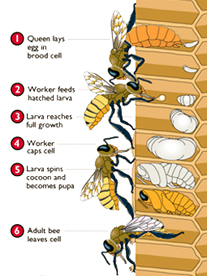

Working bees can live between 4-6 weeks and do their best to provide food and the materials to support their colony while they are alive.Īs you can see, the lifespan of a bee is heavily reliant on the environment they’re in, the pollen they can access, their gender, and what role they play in the colony. If a bee has no work duties, such as the queen bee, they can live significantly longer than a working bee or a drone. Worker bees usually live between 1-3 months.Ĭolony Duties: Lastly, the role that a bee has in the colony also determines their lifespan. Male drones have a much shorter lifespan and usually die after mating, often in midair. The queen bee is expected to live significantly longer than any other bees in the colony, up to 4 years. Gender: The gender of a bee has an impact on their lifespan.

This is because of the difference in the food and nutrition available to the bee. If they live in a region with an abundance of plants and pollen, they will likely live a bit longer than a bee who lives in a more barren region. Location and Pollen Supply: Where a bee lives has a big impact on their lifespan. Let’s take a look at what impacts the lifespan of a bee: Bees live between 1-4 years based on their gender and their role within the colony. Why Do Bees Live Only As Long As They Do?īees have short lifespans compared to other animals, but they make up for this with their hard work and the important roles they play in the environment.


Lastly, drones work with the sole purpose of mating while they’re alive. The queen bee lives much longer and is responsible for production. In only a matter of weeks, worker bees work tirelessly and put in as much work as they can while they’re alive. The lifespan of a bee is quite short and remarkably consistent based on the role they play in the hive. Drones have no other purpose in the hive.
Drones – Drones are essentially male bees whose role is to mate with the queen bee. She is the only bee responsible for reproducing and populating the colony with new bees. A single queen can live for up to 5 years and is the head producer of eggs for the colony. Queens – At the top of the hierarchy of a bee colony is the queen bee. They fly around collecting nectar and pollen, they help out around the hive, they maintain the temperature, and they help rear new bee babies. These bees live for only 6 weeks, but they accomplish a phenomenal amount of work in that short period of time. Workers – The vast majority of a bee colony is made up of female worker bees. Bee colonies follow a complex cycle of preparation and production that effectively ensures their survival. A Buzz on Bee Lifespanīee lifespans are finite but they live just long enough to accomplish their purpose. By pollinating many of our important crops, Bees greatly increase the life of the seeds and produce from their flowers. To survive even a short time, bees have to have access to food and water sources. Although a bee’s life may be short, it is particularly focused on ensuring the survival of its species. The vitamin-rich diet of bees can lead to their demise – over-consumption of pollen can reduce their lifespan dramatically. Does the food they eat impact their shelf-life?. Additionally, wild bumblebees on average have a shelf-life of only two weeks. On the other hand, drone bees only live for a maximum of 40 days, as they are raised and sent off in search of a mate, never to be seen again. Queen honeybees, for instance, can only live up to five years, making them far more precious to their hives than their worker counterparts. What kind of bees have a short shelf-life?. But few realise that bees have an incredibly short shelf-life, some bee species only lasting an average of 15 to 22 days. The life of a bee is dominated by a purposeful schedule of foraging and pollinating flowers, socialising within the hive, and eventually laying eggs and grooming young larvae. It is well-known that honeybees live for a short period, typically from four to six weeks in the summer months. But, you may wonder, how long do these tireless workers last? In this article, we’ll explore how long bees typically live and how their lifespans contribute to their role in the world. Bees are a fascinating species of insects, hard at work in the great outdoors pollinating plants and flowers, buzzing their way around our plants and gardens, and generally making sure our ecosystems are balanced and healthy.








 0 kommentar(er)
0 kommentar(er)
